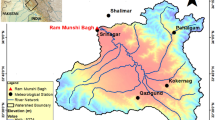Abstract
An integrated hydrologic/hydraulic model of the Kemptville Creek basin has been built using the Mike11 modeling system of the Danish Hydraulic Institute and available GIS-based watershed data. This watershed system is complex, comprising of channels, local drainage areas, lateral inflows, wetlands, and a regulated dam. The model was calibrated using measured streamflow data for five years and then validated for another five years. A wide range of methods—both qualitative and quantitative—were used to evaluate the model performance. It was found that the model can simulate high flows with a high degree of accuracy, and the low flows less satisfactorily. Additional (split-sample) validation tests were conducted for another two five-year periods, which revealed that the model is capable of performing equally well for time periods beyond those used for calibration and validation. This model is now being used for various watershed management purposes, including synthetic hydrograph generation, flood forecasting, design flood estimation, wetland function analysis, etc.
















Similar content being viewed by others
References
Ahmed F (2010) Numerical modeling of the Rideau Valley Watershed. Nat Hazard 55:65–84
Bekele EG, Knapp HV (2010) Watershed modeling to assessing impacts of potential climate change on water supply availability. Water Resour Manage 24:3299–3320
DHI (2003) Mike 11—A modeling system for rivers and channels, Reference manual. Danish Hydraulic Institute, Hørsholm
DHI (2004) NAM—Technical reference and model documentation draft. Danish Hydraulic Institute, Hørsholm
Guzha AC, Hardy TB (2010) Application of a distributed hydrological model, TOPNET, to the Big Darby Creek Watershed, Ohio, USA. Water Resour Manage 24:979–1003
Henriksen HJ et al (2003) Mehtodology for construction, calibration and validation of a national hydrological model for Denmark. J Hydrol 280:52–71
Johnston R, Kummu M (2012) Water resources models in the Mekong Basin: a review. Water Resour Manage 26:429–455
Klemeš V (1986) Operational testing of hydrological simulation models. Adv Water Resour 31:13–24
Lorup JK et al (1998) Assessing the effect of land use change on catchment runoff by combined use of statistical tests and hydrological modelling: case studies from Zimbabwe. J Hydrol 205:47–163
Madsen H (2000) Automatic calibration of a conceptual rainfall-runoff model using multiple objectives. J Hydrol 235:276–288
Madsen H (2003) Parameter estimation in distributed hydrological catchment modeling using automatic calibration with multiple objectives. Adv Water Resour 26:205–216
MNR (1985) Operation plan—Oxford Mills Dam—Brockville District. Ontario Ministry of Natural Resources, Engineering Services, Eastern Region, Canada
Moriasi DN et al (2007) Model evaluation guidelines for systematic quantification of accuracy in watershed simulations. Trans ASABE 50(3):885–900
Nash IE, Sutcliffe IV (1970) River flow forecasting through conceptual models. J Hydrol 10:282–290
Paz A et al (2010) Large-scale hydrodynamic modeling of a complex river network and floodplains. J Hydrol Eng 15:152–165
Rahman MM et al (2011) Design flow and stage computation in the Teesta River, Bangladesh, using frequency analysis and MIKE 11 modeling. J Hydrol Eng 16:176–186
Refsgaard JC, Knusden J (1996) Operational validation and intercomparison of different types of hydrological models. Water Resour Res 32:2189–2202
RVCA (2007a) Rideau River Watershed modeling using Mike11, Draft Report. Rideau Valley Conservation Authority, Manotick, Canada
RVCA (2007b) Kemptville Creek watershed plan update. Rideau Valley Conservation Authority, Manotick, Canada
RVCA (2009) Quantifying the importance of wetlands in the management of floods and droughts in the Rideau Valley Watershed. Rideau Valley Conservation Authority, Manotick, Canada
RVCA (2011a) Analysis of regulatory flood level on the shoreline of Otter Lake, for the purposes of administering Ontario Regulation 174/06. Rideau Valley Conservation Authority, Manotick, Canada
RVCA (2011b) Analysis of regulatory flood level on the Shoreline of Otty Lake, for the purposes of administering Ontario Regulation 174/06. Rideau Valley Conservation Authority, Manotick, Canada
RVCA (2012a) Analysis of regulatory flood level on the shoreline of Bobs Lake, for the purposes of administering Ontario Regulation 174/06. Rideau Valley Conservation Authority, Manotick, Canada
RVCA (2012b) Analysis of regulatory flood level on the shoreline of lower/big Rideau Lake, for the purposes of administering Ontario Regulation 174/06. Rideau Valley Conservation Authority, Manotick, Canada
Shi P et al (2011) Evaluating the SWAT Model for hydrological modeling in the Xixian Watershed and a Comparison with the XAJ Model. Water Resour Manage 25:2595–2612
Willmott CJ (1981) On the validation of models. Phys Geogr 2:184–194
Acknowledgment
This paper is based on the initial work done at RVCA. Bruce Reid, Director of Watershed Science and Engineering Services, provided encouragement and advice. S. Asif and N. Howlader did much of the model building and data analysis. All these are gratefully acknowledged. Notwithstanding the contribution of others in the original study, the opinions presented in this paper are based on further analyses conducted by and are the sole responsibility of the author, and do not necessarily represent the official position of RVCA and its staff. I appreciate the constructive suggestions of two anonymous reviewers.
Author information
Authors and Affiliations
Corresponding author
Rights and permissions
About this article
Cite this article
Ahmed, F. A Hydrologic Model of Kemptville Basin—Calibration and Extended Validation. Water Resour Manage 26, 2583–2604 (2012). https://doi.org/10.1007/s11269-012-0034-0
Received:
Accepted:
Published:
Issue Date:
DOI: https://doi.org/10.1007/s11269-012-0034-0




